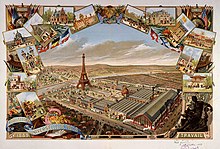Exposition Universelle (1889)
| EXPO Paris 1889 | |
|---|---|

General view of the exhibition
|
|
| Overview | |
| BIE-class | Universal exposition |
| Category | Historical |
| Name | Exposition universelle de 1889 |
| Building | Eiffel Tower |
| Area | 96 Ha |
| Invention(s) | Phonograph |
| Visitors | 32,250,297 |
| Organized by | Charles Adolph Alphande |
| Participant(s) | |
| Countries | 35 |
| Business | 61,722 |
| Location | |
| Country | France |
| City | Paris |
| Venue | Champ de Mars Trocadéro |
| Coordinates | 48°51′30″N 2°17′39″E / 48.85833°N 2.29417°E |
| Timeline | |
| Opening | May 5, 1889 |
| Closure | October 31, 1889 |
| Universal expositions | |
| Previous | Exposición Universal de Barcelona in Barcelona |
| Next | World's Columbian Exposition in Chicago |
The Exposition Universelle of 1889 (French: [ɛkspozisjɔ̃ ynivɛʁsɛl]) was a world's fair held in Paris, France, from 6 May to 31 October 1889.
It was held during the year of the 100th anniversary of the storming of the Bastille, an event considered symbolic of the beginning of the French Revolution. The fair included a reconstruction of the Bastille and its surrounding neighborhood, but with the interior courtyard covered with a blue ceiling decorated with fleur-de-lys and used as a ball room and gathering place.
The 1889 Exposition covered a total area of 0.96 km2, including the Champ de Mars, the Trocadéro, the quai d'Orsay, a part of the Seine and the Invalides esplanade. Transport around the Exposition was partly provided by a 3 kilometre (1.9 mi) 600 millimetre (2 ft 0 in) gauge railway by Decauville. It was claimed that the railway carried 6,342,446 visitors in just six months of operation. Some of the locomotives used on this line later saw service on the Chemins de Fer du Calvados.
The main symbol of the Fair was the Eiffel Tower, which served as the entrance arch to the Fair. The 1889 fair was held on the Champ de Mars in Paris, which had been the site of the earlier Paris Universal Exhibition of 1867, and would also be the site of the 1900 exposition. Since the lifts had not been completed when the Exposition opened, the first visitors had to walk up to the second floor platform. Workers had worked through the night the day before the exhibition opened to complete the necessary construction needed to safely allow patrons to set foot upon the structure. When speaking of the dedicated workers, M. Salles, the son-in-law of Eiffel made the statement that "no soldier on the battle field deserved better mention than these humble toilers, who, will never go down in history." No one other than construction personnel were allowed higher than the second floor platform.
...
Wikipedia
